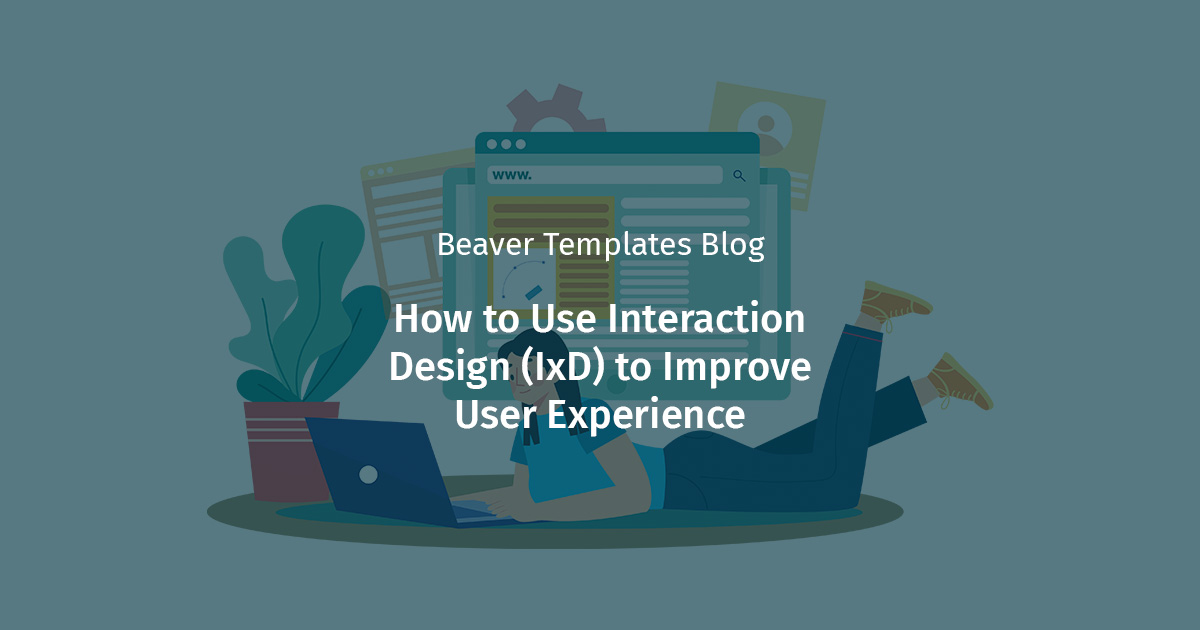In the world of modern web design, creating a nice looking site is only part of the equation. To truly engage visitors, you need to craft digital experiences that feel intuitive, enjoyable, and purposeful. That’s where interaction design (IxD) comes in.
When done well, interaction design bridges the gap between a website’s aesthetic appeal and its usability, ensuring that every click, swipe, and scroll feels effortless for your users. For web design agencies, digital marketing teams, and freelance designers, understanding IxD is essential to delivering sites that not only look great but perform exceptionally.
In this article, we’ll break down what interaction design is, why it matters for user experience, and how you can implement IxD principles in your projects, especially when building WordPress websites with Beaver Builder.
What Is Interaction Design?
The Interaction Design Foundation defines interaction design as the practice of designing the interaction between your website visitors and elements on your website. In simpler terms, it’s about how users and technology communicate with each other.
While visual design focuses on what users see, interaction design focuses on how they engage with it. This includes:
- User flows: How a visitor moves from point A to point B on a site.
- Feedback: Responses from the interface, such as hover effects, animations, or confirmation messages.
- Affordances: Visual cues that suggest how something should be used (e.g., a button that looks clickable).
- Consistency: Ensuring similar actions produce similar results across the site.
In short, IxD makes digital interactions predictable, efficient, and satisfying.
The Role of Interaction Design in Web UX
Think of a website as a conversation between your brand and the visitor. If that conversation is confusing or frustrating, the user is likely to leave. Good interaction design ensures that conversation flows naturally.
Here’s why it’s so critical for website interaction design:
- Improves usability: By guiding users through tasks with intuitive elements, IxD removes unnecessary friction.
- Encourages engagement: Micro-interactions, such as a subtle button animation, encourage interaction and keep users exploring.
- Boosts conversions: A clear, predictable path to action increases the likelihood of clicks, sign-ups, and purchases.
- Builds brand trust: A well-designed interaction flow conveys professionalism and credibility.
If your website looks amazing but fails to guide users clearly toward their goals, it’s a case of style over substance, and IxD is the fix.
Key Principles of Interaction Design
While there’s no one-size-fits-all approach, several core principles can help guide your interactive design process:
1. Clarity
Every interactive element should be instantly recognizable. Buttons should look clickable, links should be easy to find, and navigation should be obvious.
2. Feedback
Visitors should receive clear confirmation that the site has responded to their actions. This can be as simple as a color change on hover, a loading animation, or a confirmation message after submitting a form.
3. Consistency
Maintain uniform design patterns across the site. For example, if your primary CTA button is blue, all CTAs should be the same color.
4. Efficiency
Reduce the number of steps needed to complete a task. Fewer clicks typically result in higher completion rates.
5. Learnability
A user’s first experience should be intuitive enough that they can return and navigate the site without relearning.
How to Apply IxD Principles with Beaver Builder
For WordPress designers, Beaver Builder is a powerful tool for bringing IxD concepts to life. Its drag-and-drop interface and customizable modules make it easy to create engaging, user-friendly websites.
Here’s how you can integrate IxD into your website interaction design using Beaver Builder:
1. Use Visual Cues to Guide Users
Add hover states to buttons and links, use contrasting colors for CTAs, and make interactive elements visually distinct from static content.
2. Streamline Navigation
Beaver Builder’s menu modules allow for clean, intuitive navigation. Keep menus concise, logical, and consistent across all pages.
3. Create Smooth User Flows
Plan out the journey you want users to take before building. Use Beaver Builder’s layout flexibility to create pages that naturally guide visitors toward conversions.
4. Implement Feedback Through Micro-Interactions
Leverage animations, hover effects, and progress indicators to reassure users that their actions are working.
5. Optimize for All Devices
Test interactions on desktop, tablet, and mobile. Beaver Builder’s responsive controls make it easy to tailor layouts for different screen sizes.
Common IxD Mistakes to Avoid
Even experienced designers can fall into traps that undermine user experience. Watch out for:
- Overloading with animations: Motion should enhance usability, not distract from it.
- Inconsistent design patterns: If the same action produces different results in different places, users will be confused.
- Hidden navigation: Don’t bury important links behind too many clicks.
- Ignoring accessibility: Ensure your website is ADA compliant and that interactive elements are usable for people with disabilities (e.g., keyboard navigation, ARIA labels).
Measuring IxD Success
The effectiveness of your interaction design (IxD) efforts can be measured through:
- User testing: Watch real users navigate your site to identify problem areas.
- Analytics: Track metrics like bounce rate, time on page, and conversion rates.
- Heatmaps: See where users are clicking, scrolling, or ignoring content.
Tools like Microsoft Clarity or Crazy Egg can provide valuable insight into how people actually interact with your site.
Incorporate Interaction Design Principles Today
Whether you’re designing for a small business, a large brand, or your own freelance clients, applying IxD principles ensures you’re building websites that people want to use.
If you’re ready to create sites that combine visual appeal with flawless usability, start with the right tools. Beaver Templates offers professionally designed, conversion-focused Beaver Builder templates that give you a head start on crafting engaging, interactive websites.
Explore our collection of Beaver Builder website templates and see how the right foundation can make implementing IxD easier than ever.


